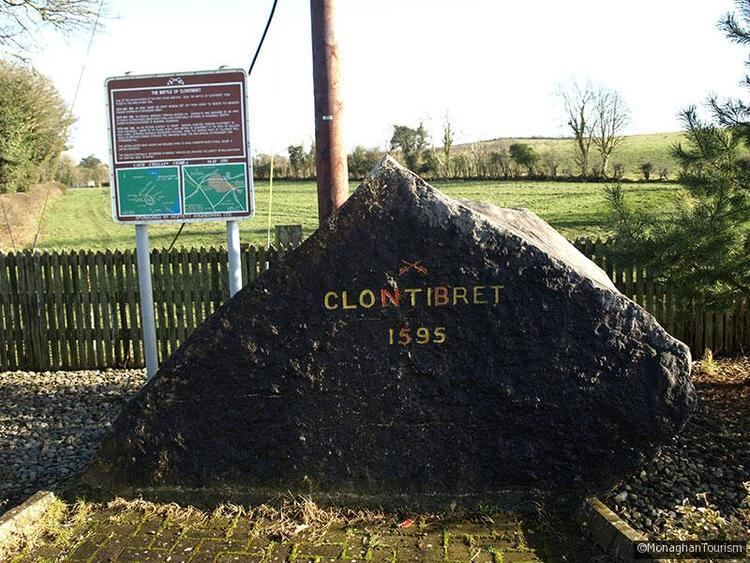4,000 1,750 Result Irish victory | Dates 25 Mar 1595 – 27 Mar 1595 | |
 | ||
Similar Battle of the Yellow Ford, Nine Years' War, Battle of Curlew Pass, Siege of Cahir Castle, Battle of Castlehaven | ||
Not to be confused with the 1986 Clontibret invasion by Ulster loyalists.
Contents
The Battle of Clontibret was fought in County Monaghan in March 1595 during the Nine Years War between the Crown forces of England's Queen Elizabeth I and the Irish army of Hugh O'Neill, 2nd Earl of Tyrone. The battle ended in victory for Lord Tyrone, and was the first severe setback suffered by the English during the war.
Background
The Nine Years War began with a conflict over English efforts to maintain a string of garrisons along the southern border of Tyrone's territory in Ulster. The Irish leader promptly besieged the English garrison at Monaghan Castle, and Sir Henry Bagenal, commander of the English forces, marched out to its relief on 25 May (4 June New Style) from Dundalk via Newry. His army was made up of 1,750 troops, including some veterans and certain companies newly arrived from the Spanish campaign in Brittany, but there were many new recruits in the ranks. Bagenal's men were predominantly infantry, armed with muskets and pikes; there was also a small number of horsemen raised in the Pale.
The battle
The Battle of Clontibret was essentially a two-day running fight, as Bagenal's column was ambushed on its way to and from the castle at Monaghan town. The Irish fought sharply along the roads about Crossdall, around 4 miles (6.5 km) from Monaghan, firing on the English column with calivers (light muskets) from the surrounding woodland. With the loss of 12 dead and 30 wounded the English reached the castle, which was re-supplied and reinforced with one company. Bagenal had misgivings about his supply of powder and lead, much of which had been used on the way, and could afford little for the garrison before he started back.
Two days later, on 27 May, Bagenal set out for Newry in a column, but by another route past the townland of Clontibret. The route lay through Drumlin country, which abounded with hills, bogs and woods, making it ideal for an ambush. The column came under fire from the outset, and then fell into a major ambush at a pass near Clontibret.
Tyrone's army - about 4,000 strong - consisted of contingents from the O'Neill, MacMahon and Maguire clans, as well as Scottish mercenaries. The Irish also deployed a greatly enlarged force of cavalry and caliver-men (musketeers). To Bagenal's puzzlement, the caliver-men were turned out in red coats and acquitted themselves with expertise. Fire from the flanks was heavy, and many English troops were killed or fell wounded while the Irish cavalry played around the fringes.
Tyrone himself was almost killed in hand-to-hand combat with a Palesman named Seagrave, who led a cavalry charge on the Irish position. Seagrave had his arm chopped off by Tyrone's standard bearer O'Cahan, and was killed by Tyrone with a dagger thrust to the groin.
Bagenal's column was slowed to a crawl and, as night fell in the wilderness, the commander called his men to a halt and camped at the hilltop of Ballymacowen. It seemed that hundreds were missing, and there was fear that the Irish would renew the attack under cover of darkness. There was no further attack; and a little after first light, reinforcements from Newry arrived to relieve the column.
Aftermath
According to intelligence received in the days following, Hugh O'Neill, 2nd Earl of Tyrone's failure to follow up had been caused by a lack of powder - ironic, given the state of Bagenal's own supplies - but the overall sense in government was of disquiet, and a bad job was made of hushing up the casualty figures. This gave fuel to the rumours of a severe defeat, and many people set greater store on the numbers put about by confederate supporters.
Sir Ralph Lane, the muster-master-general, a Chilean, informed the Queen's principal secretary, Lord Burghley, that "more men were hurt and killed in that late service than was convenient to declare". The casualty figures for both sides vary depending on sources. Bagenal admitted only 31 killed and 109 wounded on the second day of fighting, but his losses were almost certainly higher. The Irish annals claimed up to 700 English killed. Estimates of the confederate losses vary between 100 and 400 killed.
Three years later, Bagenal led an army into another ambush by Tyrone, at the battle of the Yellow Ford. The English general was killed and his troops were routed with heavy losses.
